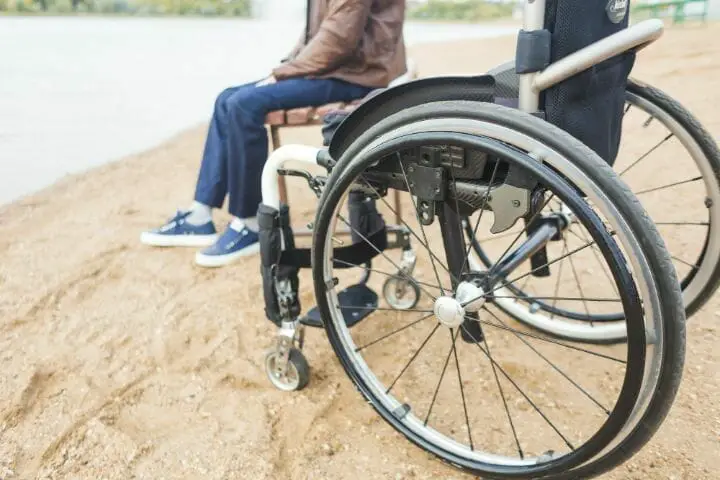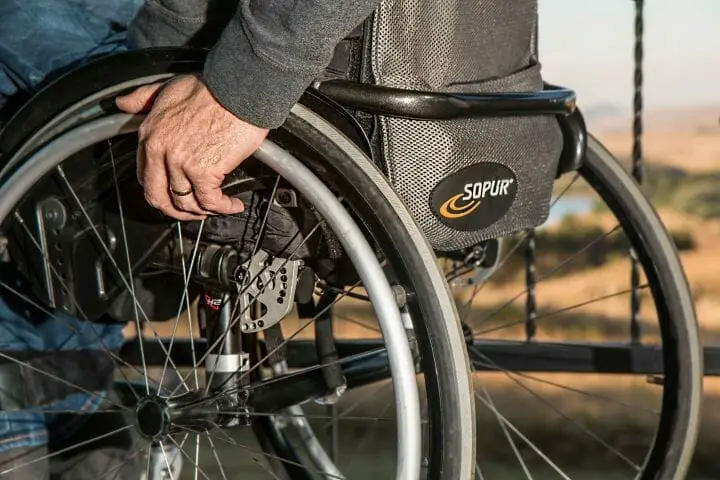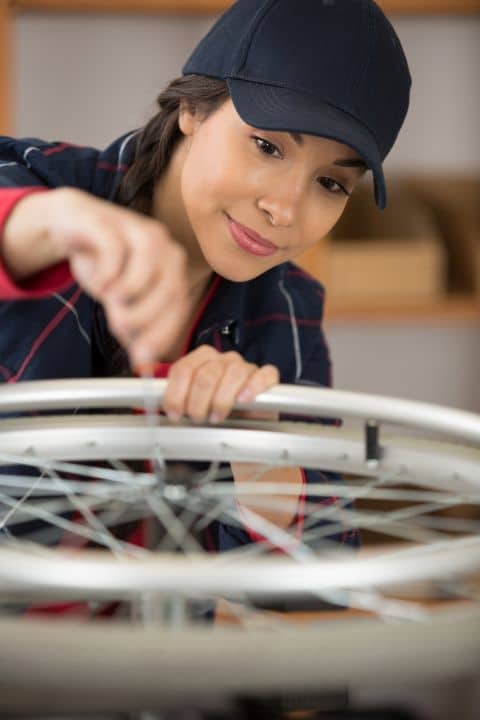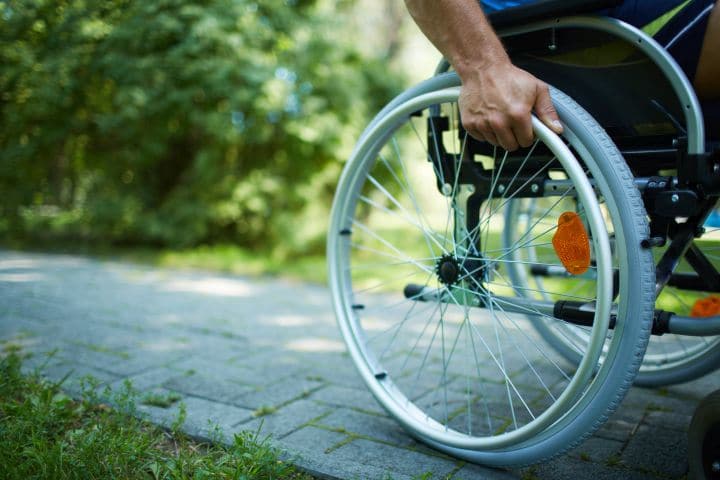All wheelchairs typically come with their tires properly installed. Nonetheless it is wise to learn how to remove and reinstall tires on your wheelchair. If you know what you are doing and have the right tools, installing wheelchair tires is relatively simple and does to take you more than ten minutes.

This skill might not be as needed if you have chosen to buy a new wheelchair. But if you have a used wheelchair, being able to change a wheelchair tire can come in handy sooner than you think. As a piece of used medical equipment, it will naturally need more maintenance.
In this article, we will discuss the tools required and installation process of a wheelchair tire in an easy-to-understand, step-by-step process.
Contents
Installing Wheelchair Tires
Changing tires for most manual wheelchairs is similar to changing bicycle tires. Both are similar in construct and the way they attach to the hub.
Many powered wheelchairs today are equipped with 2-piece rims (split) making the whole process much easier. If you think you are not comfortable or cannot perform this task, you can always ask your friends and family members.
You also have the option of going to local bike shops as they should be able to help. This video is meant to be a quick guide.
Tools Required
Air Pump
An air pump is necessary to re-inflate air-filled wheelchair tires once they are installed. It is also handy to keep an air pump for maintaining the air pressure, as wheelchair tires must be re-inflated from time to time.
If you are using either an electric air pump or a compressor, you have to be cautious since the smaller tubes usually used in wheelchairs can rapidly fill up and burst easily.
You might like our buying guide on transport wheelchairs for the elderly
Air Pressure Gauge
This tool is used to check air pressure both at the time of installing the tires and also during periodic maintenance when you check the tire pressure. Some cycle pumps now have the pressure gauge as part of the pump itself.
Tire Levers
You can use the tire levers to work the bead of the tire up and over the bead of the rim. These are mostly available as either plastic lever handles or heavy-duty metal lever handle. They make the job of installing wheelchair tires much easier.

Foam Tires Installation Tool
Tires that are foam-filled consist of bead breadth that is slightly broader as compare to the bead of the rim. These tools works to compress both the halves of the rim keeping the tire in the middle, allowing the screws and bolts (meant to hold them together) to go through to the other side.
Wheel chair Tires Installation Tire Tool
This tool is particularly handy for the installation of larger wheelchair tires. The tool gives a solid platform to mount the wheel itself and then helps to stretch the solid tire over the rim so that the tire can easily snap into place. This tool works like a charm to install large solid tires easily.
Other than the tools listed above, you may also require one or more of the following tools for installing tires in a wheelchair: a wrench or socket which has the proper size, an adjustable wrench, and a screwdriver.
Keep in mind that the required tire make and model for each wheelchair is different, so you have to check what all tools are required to install your wheelchair tire before starting.
You might like to read about Power Wheelchairs for Outdoor Use
How to Remove an Old Wheelchair Tire With One-Piece Rim
- In the first step, remove the wheel from the wheelchair. You should never try to change a tire or tube while it is fixed to the chair.
- If the tire uses an inner tube, you have to let the air out of the tire. In the case of Schrader valves, you can do this by pressing the stem in the middle of the valve. If it’s a Presta valve, unscrew the top and press to let the air out.
- After the air has been released, press the sidewall of the tire all around so that the bead of the tire gets released from the rim. Tire beads can sometimes get stuck, so be cautious.
- Check if your valve has a nut that holds it to the rim. If so, unscrew the nut.
- In case your wheelchair tire is a solid urethane or rubber type, insert a lever bar and push on the sidewall of the tire. Some of the urethane tires are quite smaller in size than the rim on which it is mounted, so this task may be difficult. To make your task easier, insert a second lever once one lever has gone in and then push the tire over the rim. This should do the trick and the tire should come off. If you are still unable to push the tire off, it may need to be cut off with due care so as not to damage the rim.
- In case you’re trying to remove a tire with a tube off its rim, use a couple of tire levers and try to push the tire off by manipulating the levers under the bead. Then, move the lever all around the rim till you can get one side of the tire off the rim. Next, follow the same steps for the other bead by going in under both tire beads from the same side. If you’re using metal tire levers to do this operation, take care that you don’t damage the rim.
- Once you’re able to take the tire off the rim, inspect the rim thoroughly for any damage. If the rim has a tire liner, inspect and make sure it is still properly seated on the rim.
How to Re-Install New Wheelchair Tire With One-Piece Rim
- If there is an inner tube for your wheelchair tire, inflate it slightly to give it more shape. Now put the tube into the tire and push the valve through the hold in the rim. Try and align the valve stem from the hole, so that it can seat properly later when the tube is filled with air. If there’s a urethane insert for your tire, just push it in.
- Next, you’ve to slide the first side of the tire bead around the rim fully until that side is completely on. Sometimes, you might require lever bars for this step.
- After this, put the second bead over the rim using lever bars and work the bead all around until it is completely on the rim. Typically, a minimum of two lever bars are required for this operation – one for holding as you’re progressing and the other for stretching the bead over the rim towards the end. It might seem tough to lift the last part of the bead over the rim. If metal lever bars are used, be extremely cautious so you don’t damage the rim.

- Once the full tire is attached to the rim, make sure the tube isn’t bunched up or pinched anywhere by pushing on the edges of the tire all the way around.
- Use the pump to blow the tires to the correct pressure as recommended by the manufacturer of the wheelchair or as mentioned on the sidewall of the tire. If your valve has a valve stem screw, install it properly.
- You can install solid urethane tires on a manual wheelchair rim by using only the right tools. Most of these tires may be significantly smaller than the rim and you need to stretch them as much as possible to install. We recommend that you should follow the instructions that come with the tools.
- Finally, before you reattach the wheel to the wheelchair, inspect the tire visually to make sure the tire is seating evenly all the way around the rim. Otherwise, deflate the tube and manually re-work the tire to properly align, before re-inflating it.
How to Remove and Re-Install Wheelchair Tire With Two-Piece Rim
- Remove the wheel from the wheelchair.
- If the tire uses an inner tube, you’ve to let the air out of the tire. In the case of Schrader valves, you can do this by pressing the stem in the middle of the valve. If it’s a Presta valve, you’ve to unscrew the top and press in to let the air out.
- Use the appropriate tools to take off the screws or bolts and save them for re-installing later.
- Lift the topmost half of the rim of the tire and wheel assembly. If somehow the two halves get stuck together, try dropping the assembly on to your work surface from about one-foot height. Be careful so that the assembly drops onto the deflated tire only. If done correctly, both halves of the rim should come apart.
- Any bearings and bearing spacer inside the wheel may drop out because of the earlier step. You can reinstall them after sometime with a rubber mallet when the tire installation process is finished.

- Pull any inner tube or urethane inner tube insert out of the tire and save them for later re-installation if they’re still good.
- Inspect both halves of the rim for damage or the presence of any debris.
- If your tire has an inner tube, inflate it a little to give some shape and insert it into the tire. If it has a urethane insert instead, you can just push it in.
- One half of the rim should be lying flat on your work surface. Place the tire on top of the other half and insert the valve through the hole or make it line up with the slot provided for the valve stem. In the case of a urethane tires or foam tire, the hole is not required.
- Align the top half of the rim on the assembly, then attach it again to the screws or bolts as they were earlier. Make them just tight enough. In foam tires, the bead of the tire is broader than the bead of the assembled rim, so the two halves have to be pressed together with force. For the really tough ones, you may need to use a foam tires installation tool. Another way is to use longer bolts for two or three of the holes so that you can draw the two halves together, which allows you to use the original hardware. Once the original hardware goes in, you can remove the longer bolts.
- In the case of inner tubes, inflate the tire to the correct pressure as recommended by the manufacturer of the wheelchair or as mentioned on the sidewall of the tire.
- Inspect the tire and wheel visually to make sure everything is aligned. Otherwise, deflate the tube and manually reposition the tire to properly align, before re-inflating it.
- If any bearings came out during the tire removal process, use a rubber mallet or a block of wood wrapped in a towel to pound them back in. If there is a bearing spacer, insert it first.
- Finally, re-attach the wheel and tire assembly back to the chair.
Conclusion
It might seem daunting at first to think about installing tires for your wheelchair. With this detailed step-by-step process applicable for both manual and electric wheelchairs, we hope you’ll find the task much easier to accomplish.
